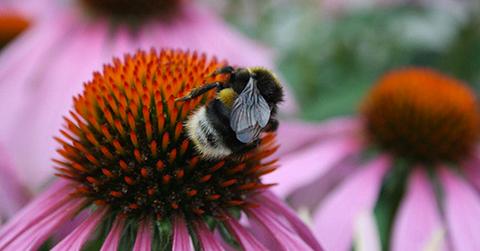Oslo, Norway Creates 'Bee Highway' To Help Strengthen Biodiversity
Bees have been dying at a rapid pace around the world but Oslo has been working to increase the bee population in its city by focusing on how making a home for bees creates a better home for humans.
Updated Nov. 19 2020, 9:41 p.m. ET
Norway's capital has been working to develop its bee population for years. Bees have been dying all over the world at a rapid pace, and it's a phenomenon that has anyone with an investigated interest in nature very worried. That should include everyone who relies on food to live: bees pollinate the vast majority of our crops, and also support pollination and biodiversity in ecosystems everywhere. We need bees, and if we want to keep them around the world has to get a lot more hospitable to them real quick.
In 2015, Oslo officials started their project to build a so-called "bee highway," meaning strategic placement of flowers, meadows, and even potted plants and rooftop gardens across the urban area. The idea is to help the insects migrate, produce and feed as regularly as possible so they wouldn't become tired and die off due to the stress of searching for food in a city. Government, private businesses, and even regular citizens joined the efforts to save bees in and around Oslo.
Two years later, The Guardian followed up on the growth of the program. City planning has been widely influenced by the project to rescue bees. The city's municipal government has established more than 10 meadows, and support workshops taught by botanists on scything and planting the bee zones. Lawns are being replaced with local grasses and wildflowers to feed the pollinators. A local NGO is even encouraging people to keep hives on their rooftops and in their backyards.
Vice-mayor Lan Marie Nguyen Berg told reporters that Oslo wants to share what they've learned while establishing these projects with other cities, saying it's an important part of a city's growth.
“We know that we need to protect and restore biodiversity even as we build new homes. In a city that is growing fast, it’s also important to make it nice to live. That means good quality green areas,” said Nguyen Berg. “We’d like to transfer the knowledge that we have to other cities.”
There's an importance to the green spaces being meadows rather than lawns. Recent studies show that industrialized agriculture has almost wiped out regular meadows full of different kinds of flowers and food for insects in nearby Denmark, and Britain has also seen a decline. Oslo's list of endangered species are dependent on the growth of meadows—24% of them are dependent on that form of ecosystem. Biologist Anna Blix told The Guardian that people don't realize many endangered animals are much smaller than what we ordinarily picture when we consider at-risk species.
“Oslo can be considered a model because we know what’s there and how to protect it,” she said. “We don’t have huge endangered mammals in meadows, but there are many important plants and insects that are at risk.”
Developing the insect corridor or "highway" is also relatively inexpensive. Though the soil needs to be cultivated and monitored for best growing practices, most of the flowers that support wildlife are technically weed. They're all also local to the area, so once planted, they tend to thrive. That's what happens when a good idea gets planted.
